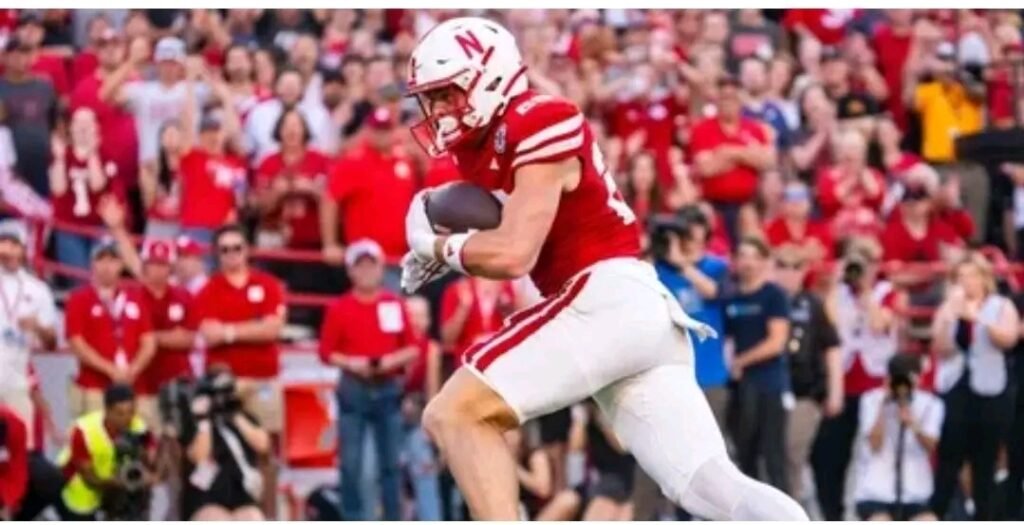LINCOLN, NE — The tight end position at Nebraska has long occupied a unique space within the program’s offensive identity — a blend of grit, versatility, and quiet heroism. And with the Cornhuskers’ most recent tight end commitment, that narrative isn’t just continuing; it’s evolving.
Nebraska’s latest pledge — a highly touted, multi-sport athlete with elite upside — steps into a tight end room already brimming with potential, retooled development philosophy, and renewed schematic purpose under Matt Rhule and offensive coordinator Marcus Satterfield.
In this edition of “Four Downs,” we analyze the implications of this addition, the current landscape of the tight end corps, and why this position may quietly become a pillar of Nebraska’s offensive renaissance.
1st Down: Identity Reset — Tight Ends in the Rhule-Satterfield Ecosystem
It’s no secret: Matt Rhule has long emphasized the tight end as a foundational element of his offensive ecosystem. From Temple to Baylor, and even during his NFL stint with the Carolina Panthers, Rhule’s schemes often leveraged TEs as chess pieces — able to function in-line, out wide, or in motion depending on the matchup.
Satterfield echoes this philosophy. Drawing from both pro-style concepts and spread principles, Nebraska’s offense is structured to:
- Feature 12 and 13 personnel packages in the red zone,
- Utilize TEs in H-back roles to disguise run/pass tendencies,
- Exploit mismatches against linebackers in play-action sets.
The TE room, then, isn’t an afterthought. It’s a strategic weapon.
“We’re looking for tight ends who aren’t just big and strong — but smart, dynamic, and adaptable,” said Rhule at a spring presser. “We want them to be matchup nightmares.”
The latest commit fits that mold precisely: athletic enough to split out wide, physical enough to block in-line, and cerebral enough to grasp complex pre-snap reads.
2nd Down: The Current Room — Young Talent Meets Veteran Grit
Let’s take stock of the current depth chart — one of the more intriguing position groups in Nebraska’s offensive infrastructure.
Key Names to Know:
- Thomas Fidone IV: Once the nation’s top-ranked TE recruit, Fidone has battled injuries but is now healthy and primed for a breakout. His athletic ceiling remains immense.
- Nate Boerkircher: The in-state grinder turned reliable contributor, Boerkircher is a rock-solid blocker with underrated receiving skills.
- AJ Rollins: A former DE/TE hybrid who’s grown into his body and could become a red zone specialist.
- Chase Androff & Brody Tagaloa: Developmental prospects with high upside, both physically imposing and coachable.
With this blend of experience and youth, the TE room is poised for rotational depth, versatility, and situational dominance.
What’s been missing? A new-generation athlete to push the ceiling higher.
The newest commit may be exactly that — an elite athlete with a basketball background, natural body control, and the work ethic to thrive in Nebraska’s development-centric ethos.
3rd Down: What the New Commit Brings — Not Just Potential, But Positional Relevance
Let’s talk specifics. The Huskers’ newest tight end commit — whose name is rapidly climbing recruiting boards — represents more than a depth addition.
Here’s why his arrival matters:
- Multi-Sport Frame: At 6’6”, 225 lbs, with fluid hips and soft hands, he fits the hybrid mold of a Travis Kelce or Dalton Kincaid type. That’s not hyperbole — that’s trajectory.
- Basketball Bloodlines: The footwork, body positioning, and vertical explosion that come from the hardwood translate beautifully to box-out catches and contested seam routes.
- Growth Mentality: Known for his “first-in, last-out” mentality, this athlete has already shown the humility to learn and the hunger to improve.
“I don’t just want to play,” he said in his commitment video. “I want to master the craft — and be the reason we move the chains on third and seven.”
Expect him to redshirt year one while developing physically and mentally, but don’t be surprised if he earns early snaps in motion packages or two-TE looks. He’s that instinctive — and that important.
4th Down: The Long-Term Vision — Nebraska’s Quiet Positional Revolution
This commitment isn’t just about today. It’s about 2025, 2026, and beyond.
In the evolving landscape of the Big Ten — now welcoming USC, UCLA, Oregon, and Washington — size and versatility at the skill positions will be even more critical. Tight ends who can block in the box and threaten downfield? They’re no longer luxuries. They’re necessities.
Rhule and Satterfield clearly understand this. With this commitment, they’re quietly stacking the room with:
- Long frames (6’5+)
- Multi-positional flexibility
- Leadership intangibles
The goal? To field a TE unit that can:
- Stay on the field in tempo
- Shift into five formations without substitutions
- Exploit defensive fatigue and personnel mismatches
In short: This isn’t just a commit. It’s a chess piece for a much larger strategy — one that’s beginning to resemble the offensive multiplicity of the best programs in the country.
Final Word: The TE Room as a Mirror of the Program
If you want to understand where Nebraska football is headed, look at the tight end room.
It’s not the flashiest position. It’s not often the headline-grabber. But it demands discipline, versatility, and buy-in — the very things Matt Rhule has preached since his arrival.
And now, with this latest commitment, Nebraska doesn’t just have another body in the room. It has another brick in the wall of a rebuilt, reimagined, and soon-to-be-resurgent offensive identity.
Because in Lincoln, the future isn’t being shouted from the rooftops. It’s being built in the weight room — and in the tight end room.

